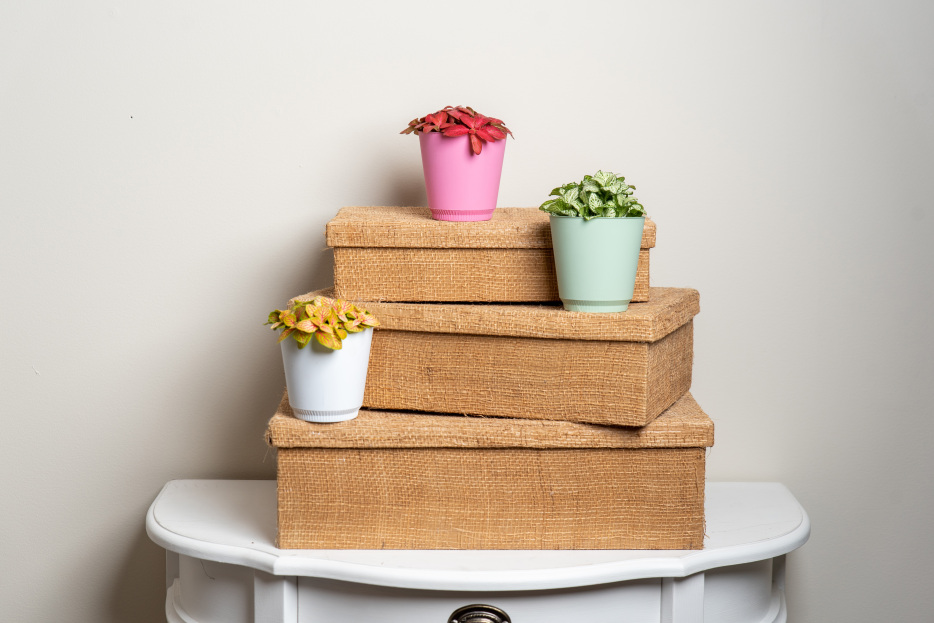
The Fittonia plant commonly known as the nerve plant or mosaic plant, traces its origins to the rainforests of South America, specifically Peru and northern Brazil.
With its stunning mosaic-like patterned leaves and relatively easy care requirements, the Fittonia is a favorite among both novice and experienced plant enthusiasts. Its adaptability to indoor environments and unique appearance led to increased cultivation as a potted indoor houseplant.
In this guide, we'll cover how to grow and care for Fittonia plants, including lighting, watering, propagation, and more.
Native to the tropical rainforests of South America, Fittonia plants are characterized by their distinctive veined leaves that come in various shades of pink, white, green, and red.
These intricate patterns give rise to its common names—nerve plant or mosaic plant. Fittonia belongs to the Acanthaceae family and is prized for its low-growing and spreading habit, making it an ideal choice for terrariums, hanging baskets, or as ground cover in the right conditions.
Fittonia's prefer bright, indirect light. While they can tolerate some shade, not enough light can cause their colors to fade and their growth to become leggy. Find a location that can provide your nerve plant bright enough but not with direct sun hitting its leaves. You can also rotate your plant every so often to ensure light reaches all sides of the plant.
Keeping the soil consistently moist is crucial for Fittonia plant care. However, be cautious not to overwater, as this can lead to root rot.Allow the top inch of the soil to slightly dry out between waterings. Consistently monitor the soil's dampness by sticking your finger into the top of its soil; if the top layer seems dry, it indicates that watering is needed. Using a well-draining potting mix can also help prevent waterlogged conditions.
Your plant will also signal to you when it really needs watering, if you notice your fittonia's leaves start to droop then its time to give your plant some water. Fittonia's are resilient and can bounce back even after the leaves start to droop, however, be sure to not let their soil dry out too long though as their leaves can dry quickly and die off. If this happens, trim off the damaged leaves, give it a good watering and give your plant a little more TLC. When watering into a pot without drainage holes, always discard the excess water that your plant does not absorb.
Given its rainforest origin, Fittonia plants thrive in high-humidity environments. If you're growing your plant indoors, especially in dry climates, consider using a humidifier or placing a tray of water near the plant to create a more humid microclimate. Misting the plant's foliage can also help maintain the moisture levels it craves. Keep the temperature between 60-80°F (15-27°C), avoiding cold drafts and sudden temperature fluctuations.
Select a container that has drainage holes to prevent water from accumulating at the roots. Fittonia plants don't appreciate sitting in waterlogged soil. A shallow container can be suitable since the plant's spreading growth habit doesn't require deep roots. If watering into a pot without drainage holes, be sure to check the bottom of the pot after watering to ensure no water collects at the bottom as this can quickly lead to root rot of your plant.
Throughout the growing period (spring and summer), nourish your Fittonia plant every 4-6 weeks using a balanced liquid plant food, diluted to 50% of the suggested potency. Avoid fertilizing during the dormant months of fall and winter when the plant's growth slows down.
You can propagate fittonia by taking stem or leaf cuttings
Regular pruning is essential for keeping your Fittonia healthy and attractive. Trim leggy stems and pinch back the growing tips to encourage bushier growth.
The Fittonia/Mosaic plant is considered pet safe!
Fittonia leaves droop when they requite water! So if you notice your leaves drooping then its a sure sign to give your plant some water. Once they absorb the water they need they will pop back to life!
Yes you can grow your fittonia in a closed or open terrarium. However It is cricual to ensure that when placed in open terrariums that your fittonia receives enough humidity and kept moist.
Fungal Infections: Fittonia plants may be prone to fungal infections such as botrytis and powdery mildew, especially when they are overwatered or placed in a poorly lit area. Indications of a fungal infection include spotting or a powdery substance on the foliage. If you think your plant is infected, remove the impacted leaves, ensure your plant receives adequate light, and reduce watering. In extreme situations, a fungicide may be necessary.
Insects: Fittonia plants can occasionally be a magnet for pests such as spider mites, mealybugs, and aphids. If you observe tiny insects on your plant or a sticky substance on its leaves or nearby, you may have an insect issue. This can often be addressed by cleaning the leaves with a cloth soaked in a soapy water solution and then rinsing the leaves. For more serious infestations, a horticultural oil or insecticidal soap may be required.
Brown foliage: This might result from insufficient moisture or the use of hard tap water. Consider utilizing purified or distilled water, and make certain your plant is situated in a high-humidity setting.
When it comes to adding a touch of vibrant beauty to your indoor space, few plants can match the visual appeal of the Fittonia.
With its striking appearance and manageable care requirements, the Fittonia plant makes for an excellent addition to any indoor plant collection. By providing the right balance of light, water, and humidity, you can enjoy the intricate beauty of this mosaic plant while watching it thrive and brighten up your living space.